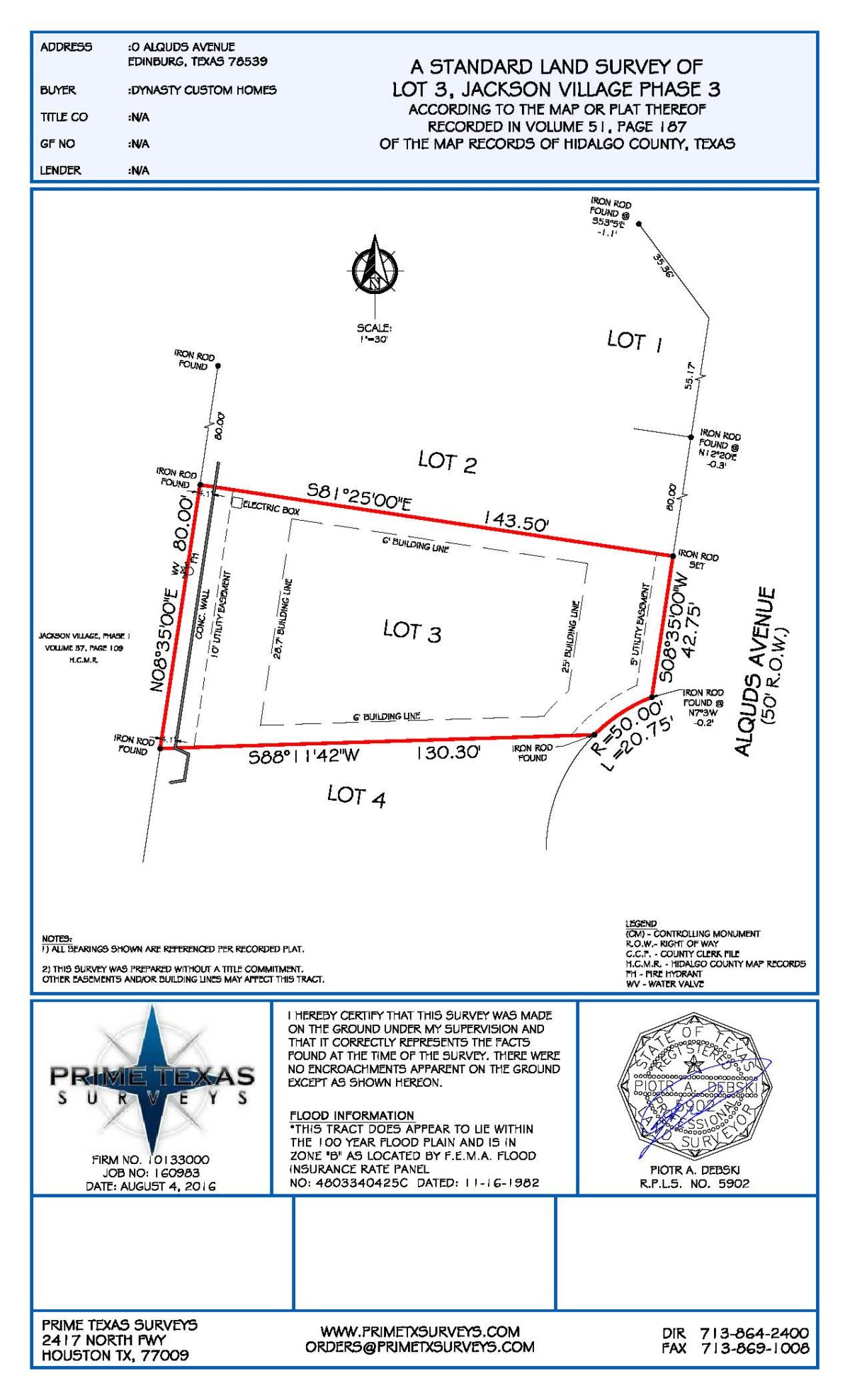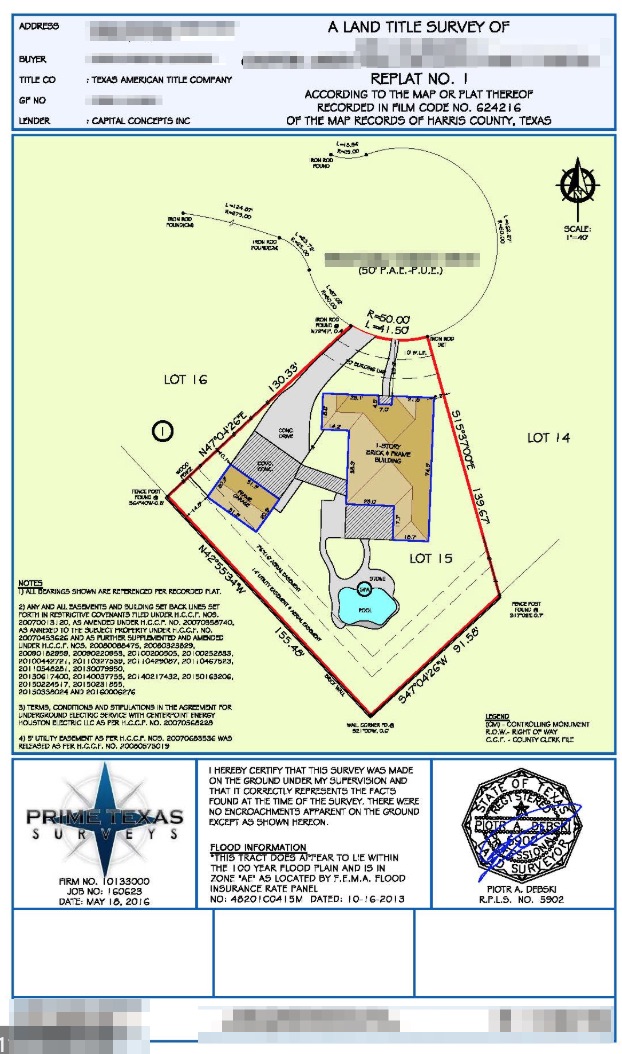If needed, your survey will be ordered at this time. The title company will order the survey at the lender’s request. This is paid at closing. Sometimes the seller will have a copy of their survey and you might be able to use it. If your lender doesn’t approve the survey, you will have to buy one.
Note: it’s recommended that you get your own survey, even if the buyer has a copy. Things change over time. Fences are installed just in or outside of your property line. It’s better to know now and correct it than to have problems in the future.


What is a property survey?
A survey is a geographical description of the boundary of a particular piece of property. A survey will display your property lines, easements, and any other permanent structures such as a swimming pool, concrete slab, or driveway. A real property survey report generally contains an illustration of the physical features of the property.
A survey:
- Creates an official and permanent official record of land placement, property lines, easements, and boundaries
- Protects against property line disputes
- Provides a point of reference in determining land value
Why should I get a survey?
A survey is required when you finance a property. At times the seller will provide a copy of their survey. Some buyers will use a seller’s survey in order to save the cost of the survey.
Purchasing a home is a huge investment. You should seriously consider getting your own survey instead of using the seller’s survey. Keep in mind that things might have changed since the seller had the survey completed. The cost of a survey is so minimal vs the cost of the home.
It is cheaper to be proactive than reactive. You will spend less now by having your property surveyed and exposing potential legal issues. Potential issues will cost more in the future when they have to be resolved in court after you have purchased the property.
How much does a survey cost?
This will vary based on the property, land, and research that has to be done. On a typical home in a subdivision, the cost is normally about $450-500. This is part of your closing costs and is not paid in advance.
Who orders the survey?
Your lender will ask the title company to order the survey.
Are there different types of surveys?
Yes. Here is a list of some of the most common surveys. There are others.
Mortgage Surveys are simple surveys that determine land boundaries and building locations. They are usually required by title companies and lenders when they provide financing to show that there are no structures encroaching on the property and that any structures on the property meet current zoning and building codes.
Boundary Surveys are used to establish the true boundaries of a property. Through previously recorded markers and the establishment of new landmarks, a surveyor will establish the true boundaries of a property and then mark the corners and lines of the plot, using markers such as iron rods, pipes or concrete monuments in the ground, or nails set in concrete or asphalt.
Subdivision Surveys are for the purpose of subdividing large tracts of land into smaller tracts, or previously undeveloped areas of land into lots, blocks, streets, parks, etc., all in accordance with the laws and ordinances established by the local and state governing agencies.
Construction Surveys are performed on a construction site to control positions, dimensions, and configurations for all site improvements specified in the construction plans throughout the course of the project. This type of surveying would include utility staking, site grading, layout of structures or buildings, and layout of streets and curbs.
Right-of-Way Surveys are performed for the purpose of laying out an acceptable route for an easement or right-of-way for a road, pipeline, utility, or transmission line. This survey would include the establishment of all boundary line and road crossings by the line along its route.
Items you will find in a property survey
Look for the legend. This will define all of the symbols, abbreviations, lines, and colors of the survey.

- Easement – Shows you who can enter or access the property. Easements will put limits on what you can do with the property. For example:
- Utility easement will allow a local utility company to access part of your property to make repairs, read meters, or install lines. Although you can enjoy the space within this easement, you can not build anything permanent on the easements.
- Right of way easements can also allow a neighbor to walk or drive through your property in order to get to their land.
If an easement is detected and it can’t be easily remedied (ex. a pool), the owners have to seek a variance in order to allow the structure to be left in place. If the owner fails to be granted the variance, the structure has to go. This can become very expensive.
- Encroachments occur when one property owner infringes on the rights of another. A common encroachment involves a fence that is built three feet onto the adjoining land or when a building is actually located partially or completely on an adjoining property. Sellers are required to tell buyers of any known encroachments. Encroachments can be serious and you should have them remedied before you purchase. Consult an attorney if needed.
- Building setback lines. These are lines designated by a developer and recorded with the county that specify how far from a street or from the property line any structures must lie. The purpose is to keep a more uniform neighborhood look and to prevent overcrowding and access to all sides of a structure.
- Structures and improvements. The survey will reflect any structures and improvements such as: a home, a pool, decks, permanent patios, and storage sheds that sit on a concrete slab, etc.
Common issues that come up in a survey:
- A neighbor’s fence encroaching onto the property.
- The garage on the property protruding onto the neighbor’s property.
- Improvements encroaching into easements or set back lines.
- Unrecorded easements (as shown by overhead power lines, pipeline markers, sewer drains, roadways or driveways).
